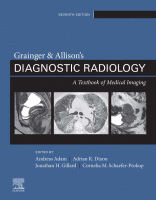Physical Address
304 North Cardinal St.
Dorchester Center, MA 02124

Anatomy Anatomically the spine is organised segmentally, consisting of 7 cervical, 12 thoracic, 5 lumbar, 5 (fused) sacral and 3 to 5 coccygeal vertebrae. Each level, except C1, consists of the following elements: a vertebral body (corpus vertebrae) anteriorly and…

Introduction Infection of the musculoskeletal system is encountered in everyday clinical practice and the scope of this chapter includes both osteomyelitis and soft-tissue infection. Osteomyelitis is defined as infection of the bone marrow and adjacent osseous structures, with or without…

Introduction This chapter considers skeletal trauma with an emphasis on the importance of the conventional radiograph in establishing the diagnosis of bone injury. The role of CT and MRI in identifying occult bone injury and more accurately defining patterns of…

Imaging of Joint Disease The imaging of joint disease is complex, with the radiologist required to combine imaging findings and clinical information to accurately characterise arthritis. This chapter details the general principles of the radiographic assessment of arthritis and the…

Bone Physiology and Pathophysiology Bone is a composite material whose extracellular matrix mainly consists of mineral (hydroxylapatite (Ca 10 (P0 4 ) 6 (OH) 2 ), collagen (mainly type 1), and non-collagenous proteins. Though bone appears rigid and inert, it…

Introduction Soft-tissue masses are frequently referred for imaging assessment. They may be benign, malignant, or non-neoplastic and all may present in a similar manner. The frequency of each type of mass is difficult to determine accurately: many patients do not…

Introduction Bone tumours can be generally divided into two groups: benign, including tumour-like lesions (see Chapter 40 ), and malignant. The malignant category can be subclassified into primary, secondary and metastatic. In common parlance the terms secondary and metastatic are…

General Characteristics of Bone Tumours Bone tumours are currently classified according to the World Health Organisation (WHO) classification of 2013 as being benign, intermediate or malignant; intermediate lesions are those that are either locally aggressive but do not metastasise (e.g.…

Introduction Magnetic resonance imaging (MRI) and ultrasound (US) complement conventional radiography and computed tomography (CT) in allowing the radiologist to undertake detailed examinations of the soft tissues of joints including tendons, ligaments, cartilage and fibrocartilaginous structures. These structures can be…

Introduction It can be argued that imaging of the musculoskeletal system has been revolutionised by the advent of magnetic resonance imaging (MRI). Despite this, our armamentarium would be incomplete without plain radiographs, computed tomography (CT), ultrasound (US) and nuclear medicine.…